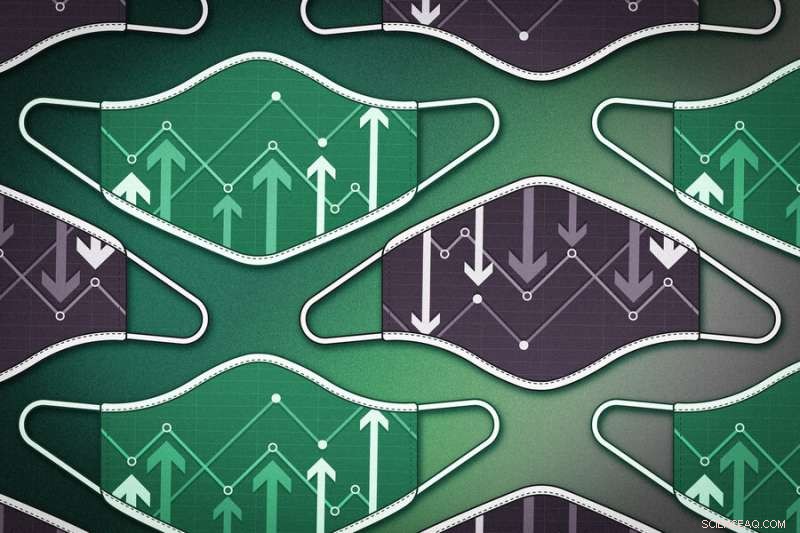
Wetenschap
Wanneer meer COVID-19-gegevens niet gelijk staan aan meer begrip

MIT-onderzoekers ontdekten dat Covid-19-sceptici op Twitter en Facebook – verre van ‘data analfabeet’ – vaak geavanceerde datavisualisatietechnieken gebruiken om te pleiten tegen voorzorgsmaatregelen voor de volksgezondheid, zoals maskermandaten. Krediet:Jose-Luis Olivares, MIT
Sinds het begin van de COVID-19-pandemie, grafieken en grafieken hebben geholpen bij het communiceren van informatie over infectiepercentages, sterfgevallen, en vaccinaties. In sommige gevallen, dergelijke visualisaties kunnen gedrag aanmoedigen dat de overdracht van virussen vermindert, zoals het dragen van een masker. Inderdaad, de pandemie is geprezen als het doorbraakmoment voor datavisualisatie.
Maar nieuwe bevindingen suggereren een complexer beeld. Een onderzoek van het MIT laat zien hoe coronavirus-sceptici online datavisualisaties hebben opgesteld om te pleiten tegen de orthodoxie van de volksgezondheid over de voordelen van maskermandaten. Dergelijke "tegen-visualisaties" zijn vaak behoorlijk gesofisticeerd, gebruikmakend van datasets uit officiële bronnen en state-of-the-art visualisatiemethoden.
De onderzoekers kamden honderdduizenden posts op sociale media door en ontdekten dat sceptici van het coronavirus vaak contra-visualisaties gebruiken naast dezelfde ‘follow-the-data’-retoriek als deskundigen op het gebied van de volksgezondheid, toch pleiten de sceptici voor een radicaal ander beleid. De onderzoekers concluderen dat datavisualisaties niet voldoende zijn om de urgentie van de COVID-19-pandemie over te brengen, omdat zelfs de duidelijkste grafieken kunnen worden geïnterpreteerd door een verscheidenheid aan geloofssystemen.
"Veel mensen beschouwen statistieken zoals infectiepercentages als objectief, "zegt Crystal Lee. "Maar dat zijn ze duidelijk niet, op basis van hoeveel discussie er is over hoe we over de pandemie moeten denken. Daarom zeggen we dat datavisualisaties een slagveld zijn geworden."
Het onderzoek wordt in mei gepresenteerd op de ACM Conference on Human Factors in Computing Systems. Lee is de hoofdauteur van de studie en een Ph.D. student in MIT's Geschiedenis, Antropologie, Wetenschap, Technologie, and Society (HASTS) programma en MIT's Computer Science and Artificial Intelligence Laboratory (CSAIL), evenals een fellow aan het Berkman Klein Center for Internet and Society van Harvard University. Co-auteurs zijn onder meer Graham Jones, een Margaret MacVicar Faculty Fellow in antropologie; Arvind Satyanarayan, de NBX Career Development Assistant Professor bij de faculteit Elektrotechniek en Informatica en CSAIL; Tanja Yang, een MIT-student; en Gabrielle Inchoco, een Wellesley College-student.
Toen datavisualisaties vroeg in de pandemie op de voorgrond kwamen, Lee en haar collega's probeerden te begrijpen hoe ze werden ingezet in het sociale media-universum. "Een eerste hypothese was dat als we meer datavisualisaties hadden, op systematische wijze verzamelde gegevens, dan zouden mensen beter geïnformeerd zijn, " zegt Lee. Om die hypothese te testen, haar team vermengde computationele technieken met innovatieve etnografische methoden.
Ze gebruikten hun computationele benadering op Twitter, bijna een half miljoen tweets schrapen die zowel naar "COVID-19" als naar "gegevens" verwezen. Met die tweets, de onderzoekers genereerden een netwerkgrafiek om erachter te komen "wie wie retweet en wie wie leuk vindt, ", zegt Lee. "We hebben in feite een netwerk gecreëerd van gemeenschappen die met elkaar communiceren." Clusters omvatten groepen zoals de "Amerikaanse mediagemeenschap" of "antimaskers". , zo niet meer dan, andere groepen.
En die visualisaties waren niet slordig. "Ze zijn vrijwel niet te onderscheiden van de bronnen die worden gedeeld door reguliere bronnen, "zegt Satyanarayan. "Ze zijn vaak net zo gepolijst als grafieken die je zou verwachten in datajournalistiek of dashboards voor volksgezondheid."
"Het is een zeer opvallende bevinding, ", zegt Lee. "Het laat zien dat het karakteriseren van antimaskergroepen als data-analfabeet of niet betrokken bij de data, empirisch onjuist is."
Lee zegt dat deze computationele benadering hen een brede kijk op COVID-19-datavisualisaties gaf. "Wat echt opwindend is aan dit kwantitatieve werk, is dat we deze analyse op grote schaal doen. Ik heb onmogelijk een half miljoen tweets kunnen lezen."
Maar de Twitter-analyse had een tekortkoming. "Ik denk dat het veel van de granulariteit van de gesprekken die mensen hebben, mist, " says Lee. "You can't necessarily follow a single thread of conversation as it unfolds." For that, the researchers turned to a more traditional anthropology research method—with an internet-age twist.
Lee's team followed and analyzed conversations about data visualizations in antimask Facebook groups—a practice they dubbed "deep lurking, " an online version of the ethnographic technique called "deep hanging out." Lee says "understanding a culture requires you to observe the day-to-day informal goings-on—not just the big formal events. Deep lurking is a way to transpose these traditional ethnography approaches to digital age."
The qualitative findings from deep lurking appeared consistent with the quantitative Twitter findings. Antimaskers on Facebook weren't eschewing data. Liever, they discussed how different kinds of data were collected and why. "Their arguments are really quite nuanced, " says Lee. "It's often a question of metrics." For example, antimask groups might argue that visualizations of infection numbers could be misleading, in part because of the wide range of uncertainty in infection rates, compared to measurements like the number of deaths. In antwoord, members of the group would often create their own counter-visualizations, even instructing each other in data visualization techniques.
"I've been to livestreams where people screen share and look at the data portal from the state of Georgia, " says Lee. "Then they'll talk about how to download the data and import it into Excel."
Jones says the antimask groups' "idea of science is not listening passively as experts at a place like MIT tell everyone else what to believe." He adds that this kind of behavior marks a new turn for an old cultural current. "Antimaskers' use of data literacy reflects deep-seated American values of self-reliance and anti-expertise that date back to the founding of the country, but their online activities push those values into new arenas of public life."
He adds that "making sense of these complex dynamics would have been impossible" without Lee's "visionary leadership in masterminding an interdisciplinary collaboration that spanned SHASS and CSAIL."
The mixed methods research "advances our understanding of data visualizations in shaping public perception of science and politics, " says Jevin West, a data scientist at the University of Washington, who was not involved with the research. Data visualizations "carry a veneer of objectivity and scientific precision. But as this paper shows, data visualizations can be used effectively on opposite sides of an issue, " he says. "It underscores the complexity of the problem—that it is not enough to 'just teach media literacy." It requires a more nuanced sociopolitical understanding of those creating and interpreting data graphics."
Combining computational and anthropological insights led the researchers to a more nuanced understanding of data literacy. Lee says their study reveals that, compared to public health orthodoxy, "antimaskers see the pandemic differently, using data that is quite similar. I still think data analysis is important. But it's certainly not the salve that I thought it was in terms of convincing people who believe that the scientific establishment is not trustworthy." Lee says their findings point to "a larger rift in how we think about science and expertise in the U.S." That same rift runs through issues like climate change and vaccination, where similar dynamics often play out in social media discussions.
To make these results accessible to the public, Lee and her collaborator, CSAIL Ph.D. student Jonathan Zong, led a team of seven MIT undergraduate researchers to develop an interactive narrative where readers can explore the visualizations and conversations for themselves.
Lee describes the team's research as a first step in making sense of the role of data and visualizations in these broader debates. "Data visualization is not objective. It's not absolute. It is in fact an incredibly social and political endeavor. We have to be attentive to how people interpret them outside of the scientific establishment."
This story is republished courtesy of MIT News (web.mit.edu/newsoffice/), a popular site that covers news about MIT research, innovatie en onderwijs.
 Nieuwe eiwit-nanobioreactor ontworpen om duurzame productie van bio-energie te verbeteren
Nieuwe eiwit-nanobioreactor ontworpen om duurzame productie van bio-energie te verbeteren Kristallisatie bij lage temperatuur van fasezuiver α-formamidiniumloodjodide mogelijk gemaakt door studie
Kristallisatie bij lage temperatuur van fasezuiver α-formamidiniumloodjodide mogelijk gemaakt door studie Hoe de massa te berekenen
Hoe de massa te berekenen Dunne waterlagen zijn veelbelovend voor de energieopslag van de toekomst
Dunne waterlagen zijn veelbelovend voor de energieopslag van de toekomst Deze kleine, zelfassemblerende vallen vangen PFAS
Deze kleine, zelfassemblerende vallen vangen PFAS
 Gegevens van 29, 798 opruimacties over de hele wereld onthullen enkele van de ergste zwerfvuilplekken
Gegevens van 29, 798 opruimacties over de hele wereld onthullen enkele van de ergste zwerfvuilplekken Zijn bomen op boerderijen de toekomst voor de houtindustrie?
Zijn bomen op boerderijen de toekomst voor de houtindustrie? Top 6 innovaties in zonne-energie
Top 6 innovaties in zonne-energie  Langetermijnmetingen laten zien hoe het klimaat verandert
Langetermijnmetingen laten zien hoe het klimaat verandert Stoffen die worden gebruikt in huishoudelijke artikelen tasten het immuunsysteem van een kustmossel aan
Stoffen die worden gebruikt in huishoudelijke artikelen tasten het immuunsysteem van een kustmossel aan
Hoofdlijnen
- Twee soorten spitssnuitdolfijnen duren erg lang, diepe duiken voor hun grootte
- Een plantenceldiagram maken
- Epitheliale cellen: definitie, functie, typen en voorbeelden
- 10 onderzoeken die compleet bizarre dingen met elkaar verbinden
- Wat zijn de functies van de linker en rechter Atria?
- Hoe gendoping werkt
- Studie van zeedieren suggereert dat het zenuwstelsel meerdere keren onafhankelijk is geëvolueerd
- Kunnen eukaryoten overleven zonder mitochondria?
- Genieten criminele psychopaten van de angst van andere mensen?
- Het onthullen van bedwantsenplagen aan potentiële huurders kan verhuurders geld besparen

- Het belang van de puberteit:een oproep voor betere onderzoeksmodellen

- Studie onderzoekt Indias beleid voor financiële inclusie van mensen zonder bankrekening

- Pop-up fietspaden en grassroots speeltuinen:hoe COVID-19 steden zal veranderen

- Narcistische CEO's verzwakken samenwerking en integriteit

 Onderzoekers verlengen de levensduur van kernreactoren en verbeteren hun veiligheid
Onderzoekers verlengen de levensduur van kernreactoren en verbeteren hun veiligheid Communicatie tussen twee immuunsysteemcellen
Communicatie tussen twee immuunsysteemcellen  Onderzoekers bestuderen hoe nanodeeltjes zichzelf assembleren tot specifieke structuren
Onderzoekers bestuderen hoe nanodeeltjes zichzelf assembleren tot specifieke structuren The Ecosystems of Ghana
The Ecosystems of Ghana Grafeen maakt rubber rubberachtiger
Grafeen maakt rubber rubberachtiger Wat verzacht de gevolgen van een recessie voor bedrijven?
Wat verzacht de gevolgen van een recessie voor bedrijven? Crowd mapping gendergelijkheid - een krachtig hulpmiddel voor het vormgeven van een betere stadslancering in Melbourne
Crowd mapping gendergelijkheid - een krachtig hulpmiddel voor het vormgeven van een betere stadslancering in Melbourne Converteren naar metrische eenheden met decimalen
Converteren naar metrische eenheden met decimalen
- Elektronica
- Biologie
- Zonsverduistering
- Wiskunde
- Italian | Portuguese | Swedish | German | Dutch | Danish | Norway | French | Spanish |

-
Wetenschap © https://nl.scienceaq.com

